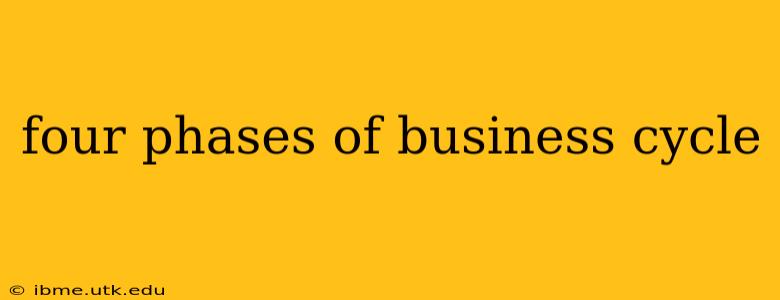The business cycle, also known as the economic cycle, is the natural fluctuation in economic activity that an economy experiences over time. It's characterized by periods of expansion and contraction, impacting various aspects of the economy, from employment rates to consumer spending. Understanding these phases is crucial for businesses, investors, and policymakers alike. This article will explore the four primary phases: expansion, peak, contraction, and trough, examining their characteristics and providing real-world examples.
What are the four phases of the business cycle?
The four phases of the business cycle are expansion, peak, contraction, and trough. These phases are not of equal length and can vary significantly in duration and intensity.
1. Expansion: Growth and Opportunity
The expansion phase is characterized by increasing economic activity. Key indicators like GDP (Gross Domestic Product) growth, employment rates, consumer spending, and business investment all rise. This period is generally positive, with businesses experiencing increased profits and consumers enjoying higher levels of disposable income.
-
Characteristics of Expansion:
- Rising GDP
- Increasing employment
- Higher consumer spending and confidence
- Increased business investment
- Rising inflation (potentially)
- Low interest rates (typically)
-
Example: The period from the mid-1990s to 2000 in the United States is often cited as an example of a robust expansionary phase, fueled by technological advancements and increased productivity.
2. Peak: The Highest Point
The peak marks the end of the expansion phase. It's the highest point of economic activity before a downturn begins. At this point, most economic indicators reach their highest levels. Inflation might be high, and resources may become scarce. The peak is often unsustainable, as it represents a temporary point of maximum economic activity.
-
Characteristics of Peak:
- GDP growth slows or stagnates
- Inflation may be high
- Interest rates may start to rise
- Resource scarcity may become apparent
- Consumer confidence might start to waver
-
Example: The dot-com bubble burst in 2000 marked a peak in the late 1990s expansion, followed by a period of contraction.
3. Contraction: Slowdown and Recession
The contraction phase, sometimes referred to as a recession if severe enough, is characterized by a decline in economic activity. GDP growth turns negative, unemployment rises, consumer spending falls, and businesses reduce investment. This phase can last for several months or even years, depending on its severity.
-
Characteristics of Contraction:
- Falling GDP
- Rising unemployment
- Decreasing consumer spending and confidence
- Reduced business investment
- Falling inflation (potentially deflation)
- Interest rates may start to fall
-
Example: The Great Recession of 2008-2009 was a significant contraction phase, triggered by a housing market crash and subsequent financial crisis.
4. Trough: The Lowest Point
The trough represents the lowest point of economic activity during the contraction phase. It's a turning point, marking the end of the decline and the potential beginning of a new expansion. Economic indicators typically reach their lowest levels at the trough before starting to recover.
-
Characteristics of Trough:
- GDP growth begins to stabilize
- Unemployment may remain high
- Consumer confidence is low
- Business investment remains cautious
- Inflation is typically low
-
Example: The trough of the Great Recession was reached in late 2008 or early 2009, after which a gradual recovery began.
How Long Do Business Cycles Last?
The duration of each phase, and the entire cycle, varies considerably. Some cycles last only a few years, while others can extend for a decade or more. Various factors influence the length and intensity of business cycles, including technological innovation, government policies, global events, and consumer confidence. Predicting the precise timing and duration of these cycles remains a significant challenge for economists.
What causes business cycles?
Several factors contribute to the cyclical nature of economic activity. These include shifts in aggregate demand and supply, technological innovations, changes in government policies (monetary and fiscal), and external shocks (like wars or pandemics). The interplay of these factors creates the dynamic and unpredictable nature of business cycles.
How to Prepare for Different Phases of the Business Cycle?
Understanding the business cycle's phases allows businesses to adapt their strategies. During expansion, businesses might focus on growth and investment. During contraction, they might prioritize cost-cutting and efficiency. This proactive approach helps businesses navigate the economic fluctuations and enhance their resilience.
This overview provides a foundational understanding of the four phases of the business cycle. By comprehending these phases and their underlying dynamics, individuals and businesses can make more informed decisions and better prepare for the ever-changing economic landscape.
